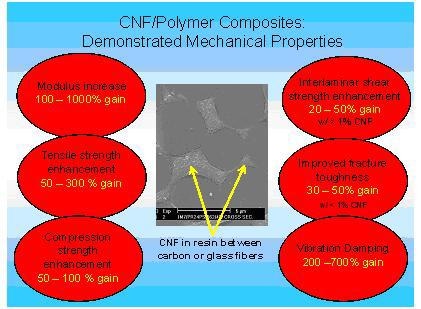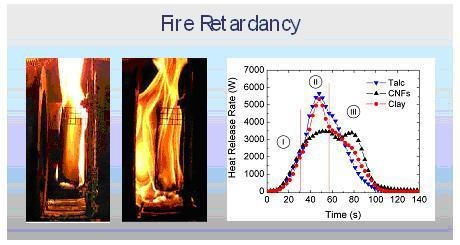Pyrograf®-III vapor-grown carbon nanofibers are within the class of materials termed multi-walled carbon nanotubes (MWCNTs), and are produced by the floating catalyst method. Carbon nanofibers (CNFs) are discontinuous, highly graphitic, highly compatible with most polymer processing techniques, and they can be dispersed in an isotropic or anisotropic mode. CNFs have excellent mechanical properties, high electrical conductivity, and high thermal conductivity, which can be imparted to a wide range of matrices including thermoplastics, thermosets, elastomers, ceramics, and metals. Carbon nanofibers also have a unique surface state, which facilitates functionalization and other surface modification techniques to tailor/engineer the nanofiber to the host polymer or application. Carbon nanofibers are available in a free-flowing powder form (typically 99% mass is in a fibrous form). Typical physical properties of Pyrograf carbon nanofibers available from Aldrich Materials Science are listed in Table 1.
Table 1. Select Properties of Pyrograf Carbon Nanofibers
| Property |
Product |
| Aldrich Product Number |
719811
|
719803
|
719781
|
| Pyrograf Product Number |
PR-25-XT-PS
|
PR-25-XT-LHT
|
PR-25-XT-HHT
|
| Average Bulk Density of Product (lb/ft3) |
1.2 – 3.0
|
1.2 – 3.0
|
1.2 – 3.0
|
| *Nanofiber Density (including hollow core) (g/cm3) |
1.4 - 1.6
|
1.4 - 1.6
|
1.4 - 1.6
|
| Nanofiber Wall Density (g/cm3) |
2.0 - 2.1
|
2.0 - 2.1
|
2.0 - 2.1
|
| Average Catalyst (Iron) Content (ppm) |
< 14,000
|
< 14,000
|
< 100
|
| Average Outer Diameter, (nm) |
125 - 150
|
125 - 150
|
125 - 150
|
| Average Inner Diameter, (nm) |
50-70
|
50-70
|
50-70
|
| Average Specific Surface Area, m2/g |
65 - 75
|
35 – 45
|
20 - 30
|
| Total pore volume (cm3/g) |
0.140
|
0.124
|
0.075
|
| Average Pore Diameter(angstroms Å) |
82.06
|
126.06
|
123.99
|
* This density should be used to convert mass fractions into volume fractions in a composite.
Product Description and Specifications
Pyrograf®-III vapor-grown carbon nanofibers possess a unique morphology (Figure 1) not currently available from other nanomaterial producers. The individual nanofiber is precipitated from a catalyst particle, and has a hollow core that is surrounded by a cylindrical fiber comprised of highly crystalline, graphite basal planes stacked at about 25 degrees from the longitudinal axis of the fiber. This morphology, termed "stacked cup" or "herringbone", generates a fiber with exposed edge planes along the entire interior and exterior surfaces of the nanofiber. These edge sites are reactive, relative to the basal plane of graphite, and facilitate chemical modification of the fiber surface for maximum incorporation and mechanical reinforcement in polymer composites. This open architecture also facilitates rapid intercalation and de-intercalation by heterogeneous atoms, useful for tuning conductivities.

Figure 1. HRTEM micrographs of PR-25 carbon nanofiber showing exposed edge sites forming the inner and outer surfaces of the nanofiber wall
The carbon nanofibers being offered through Aldrich Materials Science have average diameters ranging from 125 to 150 nm depending upon the grade, and have lengths ranging from 50 to 100 µm. The nanofibers are much smaller in diameter than conventional continuous or milled carbon fibers (5-10 nm) and significantly larger than carbon nanotubes (1-20 nm), yet offer many of the same benefits. The carbon nanofibers are treated after production in order to impart various properties on the surface state. Three types of nanofibers are available. The first is pyrotically stripped (Aldrich Prod. No. 719811) to remove surface hydrocarbons and generate a pristine surface for chemical bonding. This product also serves as a precursor for the other two listings. The second listing is thermally treated to 1500°C (Aldrich Prod. No. 719803) to provide the best combination of mechanical and electrical properties. Finally, the third listing is thermally treated to 2900°C (Aldrich Prod. No. 719781) to generate a catalyst free product and maximize thermal conductivity properties in composites.
Properties and Applications
Electrical Conductivity
Endo et al. first reported the intrinsic conductivity of highly graphitic vapor-grown carbon fiber at room temperature to be 5 x 10-5 Ω.cm, which is near the resistivity of graphite. Since virtually all of the electrical conductivity in carbon nanofiber/polymer composites is through the network of carbon nanofibers, it is clear that good fiber dispersion and maintenance of fiber length will aid in achieving high composite electrical conductivity at even a low fiber loading. Due to their high electrical conductivity and high aspect ratio, CNF can impart equivalent electrical conductivity to a composite at lower loadings than conventional conductive fillers. Also, by controlling the loading, one can produce composites with different electrical resistivity values. This is of particular importance for applications that require a resistivity in different ranges such as electrostatic dissipation (ESD) {106 – 108 Ω.cm}, electrostatic painting {104 – 106 Ω.cm}, EMI shielding {103 – 101 Ω.cm}, and lightning strike protection {< 10 Ω.cm}.
The following figure represents percolation curves possible with different CNF loading levels and shear conditions. Higher shear levels during composite processing lead to higher percolation thresholds.

Figure 2. Volume electrical resistivity of the composites made with CNF as a function of fiber weight loading.
Mechanical Reinforcement
Direct measurement on individual nanometer scale fibers has only recently been achieved and only reproducibly in limited quantities. Ozkan et al. performed careful tensile strength measurements directly on individual carbon nanofibers and measured the true strengths. Based on the annular cross-sectional area, strengths were found to be as high as 8.7 GPa, which approaches the strength of graphite microfibers. The modulus of the carbon nanofiber is inferred to be 600 GPa based on direct measurements of the parent classes of carbon nanofiber, or macroscopic vapor-grown carbon fibers.6 When incorporated into polymeric composites, the carbon nanofiber can increase the tensile strength, compression strength, Young’s modulus, interlaminar shear strength, fracture toughness, and vibration damping of the base polymer. The extent of improvement is dependent upon the type of polymer, the degree of dispersion, and processing history.

Figure 3. Overview of the mechanical properties of CNF-based composite materials.
Thermal Properties
The thermal conductivity of the carbon nanofiber can be inferred to be 2000 W/m-K again, based on direct measurements of the parent classes of carbon nanofibers, or macroscopic vapor-grown carbon fibers. Of the three carbon nanofiber types, only the nanofiber thermally treated nanofiber to 2900+°C (Aldrich Prod. No. 719781) provides a significant boost to the thermal conductivity of the polymer composite. Lafdi and Matzek were able to achieve an increase of thermal conductivity from 0.2 W/m-K for epoxy resin to 2.8 W/m-K for a 20 wt% Vapor Grown CNF composite. These results indicate that, unlike strength or stiffness, good coupling to the matrix is not necessary to achieve high thermal conductivity, making compounding less critical.
Other researchers have focused on the fire retardant properties of the carbon nanofibers in thermoplastic materials. Composites loaded with carbon nanofibers and exposed to a flame exhibited delayed and lower peak heat release rates, lower smoke emissions, and no dripping or pooling of molten polymer.

Figure 4. Enhanced Fire Retardancy of CNFs vs Talc and Clays. Used with permission from NIST: Polymer for Advanced Technologies, June 2008
Given that graphite has a low thermal expansion, polymeric composites loaded with carbon nanofibers were not only expected but have been shown to have substantially lower coefficients of thermal expansion of than the neat matrix.

Figure 5. A graph to show the reduced coefficient of thermal exapansion (CTE) of a 15 vol % CNF composite vs the neat polymer material.

This information has been sourced, reviewed and adapted from materials provided by Sigma Aldrich.
For more information on this source, please visit Sigma Aldrich.